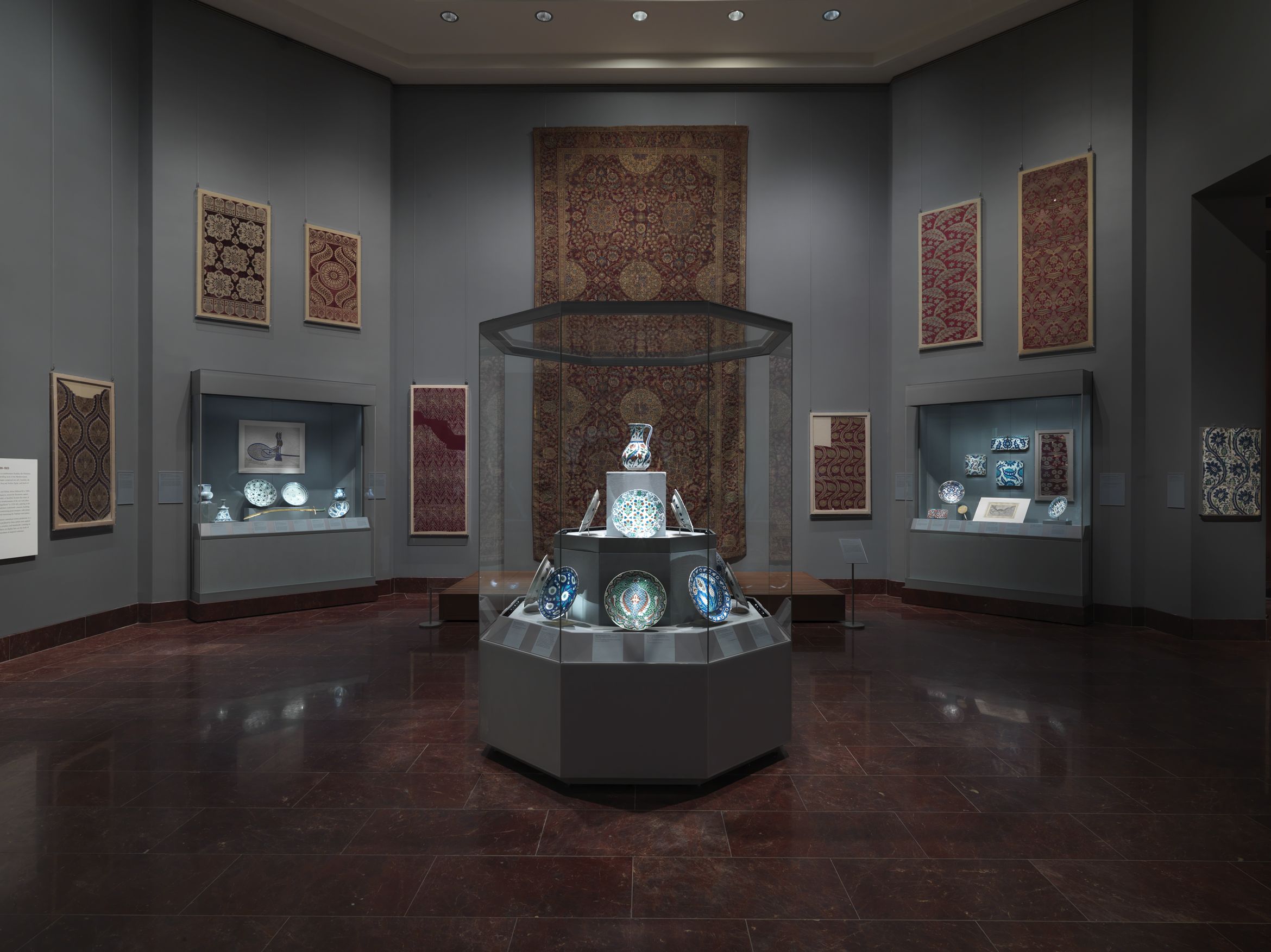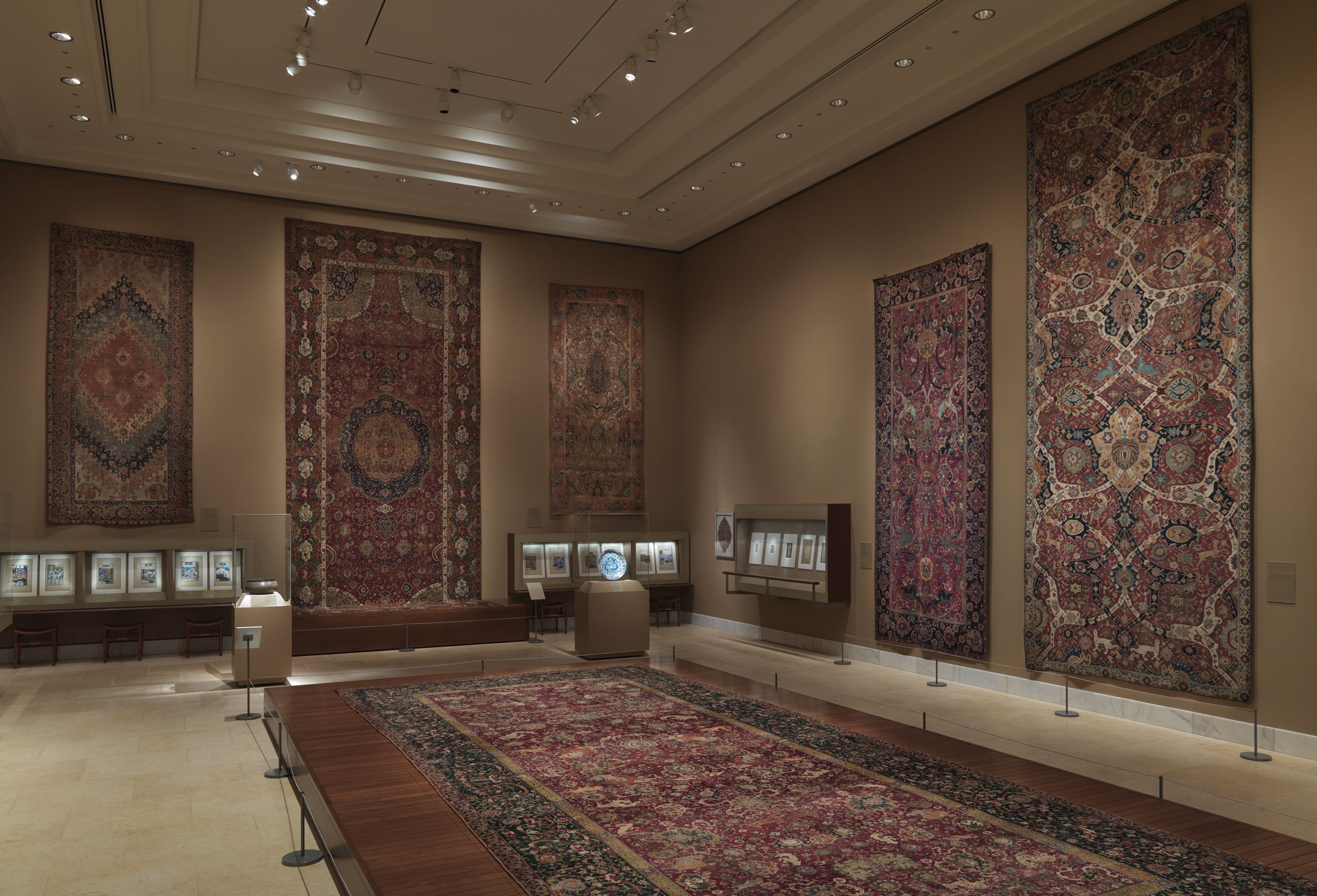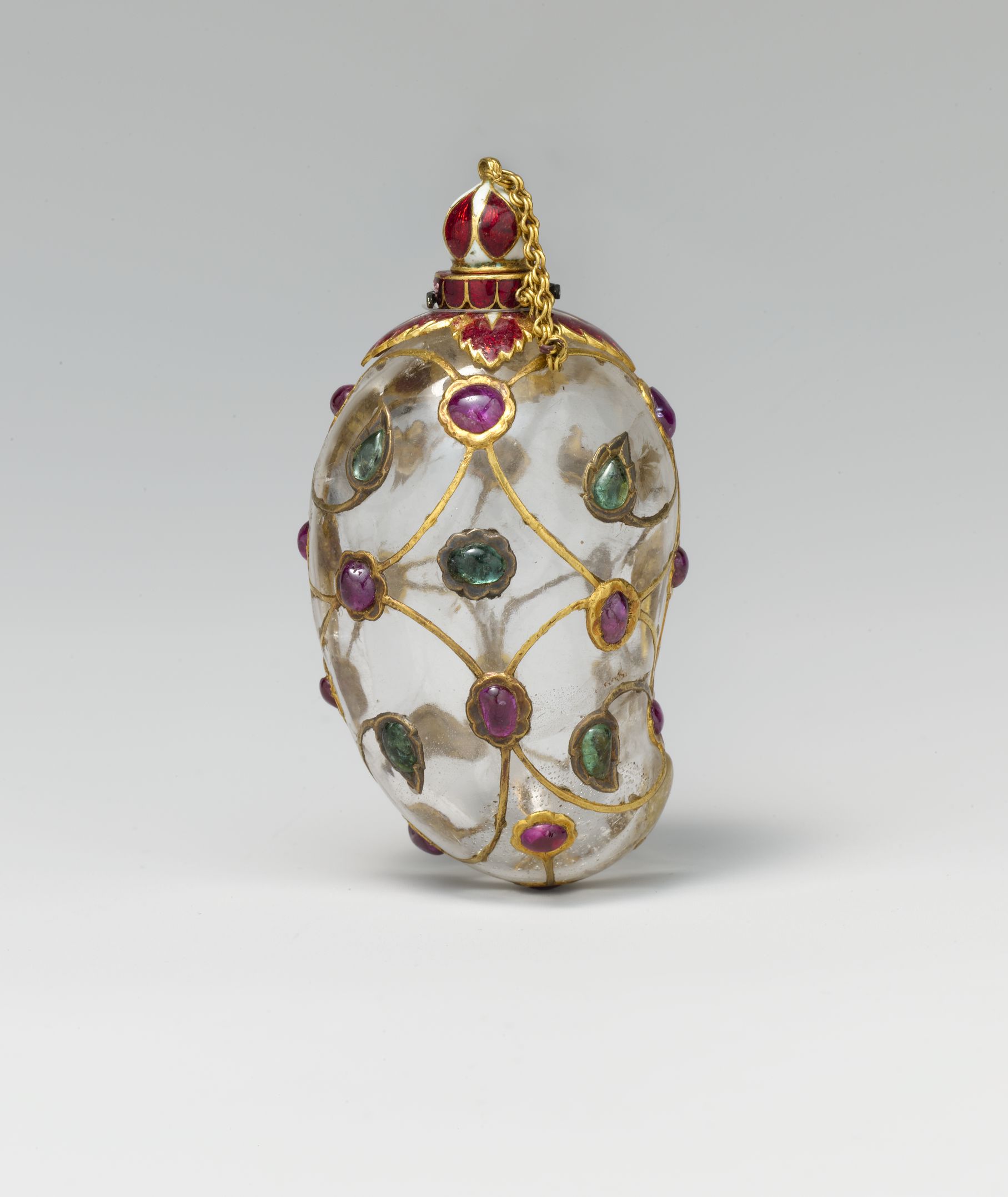In post 9/11 America, where culture has become a battleground for warring ideas and New York City is precariously positioned as its epicenter, Islamic art is in fashion again. This time, however, it is not the tricky, definition-defying territory of contemporary art that is being touted as a window into the impenetrable souls of Muslims, it is Islamic art in its historical sense—the art and architecture that emerged during centuries of dynastic rule throughout West, Central, and South Asia, across the Mediterranean, and down through North and Sub-Saharan Africa (although not necessarily in that order). The span of history that is often covered under the term “Islamic art” begins in the seventh century with the first organization of Muslim societies under the Prophet Mohammad’s successors and ends with the Ottoman Empire amidst its demise during the First World War. Although it has often been studied according to the rise and fall of Islamic rule across a vast geographical area, a clear definition of “Islamic art” remains murky even among contemporary scholars.
It is against this backdrop that the Metropolitan Museum of Art has reopened and renamed its galleries for Islamic art under the title: Art of the Arab Lands, Turkey, Iran, Central Asia and Later South Asia. Having closed just before the American invasion of Iraq in 2003 (although apparently the timing was merely coincidental), the Met has spent eight years and forty million dollars renovating and expanding these galleries. During this time, the museum’s department of Islamic art is said to have conducted new research, restored several pieces, and reformulated the curatorial lens through which 1,200 of its 12,000 artworks are presented to the public. In doing so, the department contends that it is responding to a recent shift in scholarship that is beginning to rethink Islamic art history.
Highlights of this vast collection are now divided into fifteen galleries according, in part, to modern day geography with an emphasis on the specific areas to which Islam spread under its Caliphates. Yet this does not necessarily depart from the usual ways in which Islamic art has been examined in Western academia despite the Met’s insistence that its new galleries are considering current debates on the subject. Each gallery showcases artworks or objects that are emblematic of some of the most celebrated styles and techniques that emerged, as the aesthetic of Islamic art reached certain regions over the span of thirteen centuries. In some instances, as in the gallery exhibiting Ottoman era art (1299-1923), ceramics, textiles and calligraphic works provide visual evidence of the development and transformation of forms as they encountered local cultures. In others, as in the galleries for Mamluk Egypt and Syria (1250-1517), a focus on a single material or object, in this case the enameled and gilded glass lamps that were used to create striking effects on interiors, oddly takes precedent over artifacts that might speak of greater achievements in the overall history of the aesthetic, such as the period’s development of architecture within an urban setting through which exteriors became integral parts of the cultural landscape.

[Gallery 460: Art of the Ottoman Court (14th-20th centuries) Image © The Metropolitan Museum of Art, New York]
Although the galleries are organized somewhat chronologically (periods and regions tend to overlap due to the transfer of trends, techniques, and even artisans amidst competing dynasties), the visitor has the option of accessing this permanent display through several entrances, including the museum’s section for nineteenth century European painting—the idea being that each room possesses enough of a selection of Islamic art’s basic attributes. These forms are most commonly understood as including calligraphy, geometric design, and highly stylized depictions of flora and fauna. Architecture and its delineation of sacred versus secular space through both the layout and ornamentation of structures is also essential, as buildings often incorporated and played off of the visual dynamism of the written word, geometric abstraction, and vegetal patterns. In the galleries for Art of the Arab Lands, Turkey, Iran, Central Asia, and Later South Asia, these details are on display under a sweeping classification in which art is often mixed with visual culture with little to no separation between functional objects and works of art, leading to the ubiquitous question: what is Islamic art?
If we are to follow the logic of conventional art history, in which an aesthetic can be distinguished according to the visual components that arose within the geographical, social, and political parameters of a specific culture at a given moment, then the initial step of defining Islamic art would be to examine why the aesthetic came about in the first place. What are the basic components of Islamic art? What do they mean? How and why, like any visual entity, does Islamic art use representation? What are the artistic intentions of this representation and how might it be aimed at the viewer? From there the next set of questions might venture into the historical evolution of this aesthetic across time and space as a means of communication and/or creative expression. How was Islamic art used? What societal impact did it have once it began to take hold? How did it change over time? Who and what were responsible for these changes and in what ways?

[Gallery 462: Safavid and Later Iran (16th-20th centuries) Image © The Metropolitan Museum of Art, New York]
Part of the present-day debate over what can fall under the category of Islamic art stems from the fact that many of these questions are left unanswered by the very institutions that are poised as custodians of such information. As the international art world finally becomes global, with new art centers in places like Hong Kong and Dubai redirecting the focus of the art market, a spotlight is being placed on contemporary culture outside of the long-held peripheries of the West. By default, this includes a reassessment and expansion of previous scholarship, since much of the development of Western art history has often depended on the demand for knowledge that emerges when art is viewed as a commodity. This of course has everything to do with official policies, foreign policy to be exact. A number of critical observations have been made over the past decade on the intentions, impact, and packaging of such interest, unmasking it for what much of it really is. Yet one of the most important outcomes of this redirecting of discourse is that the exact subjects who are being so closely studied are beginning to speak out, asserting their voices in the redefinition of scholarship. This has proven to be disastrous for the Euro-American tradition of art history, as prevailing notions are heavily scrutinized.
At an international conference in Amsterdam earlier this year, curators, historians, and artists were invited to brainstorm and discuss the advantages of exhibiting Islamic Art in the Netherlands as a means of educating the Dutch public on Islam and its place in contemporary culture. The intention of “Presenting ‘Islamic’ Art in a Contemporary Context,” which was organized by the Messis Foundation, was to strategize how museums and galleries can facilitate the exhibiting of “art of Islamic cultures” to today’s audiences. From the onset of the conference, which included presentations by curators from the British Museum, the Victoria and Albert Museum and the Metropolitan Museum of Art, much discussion was aimed at first establishing a clear definition of Islamic art. As this became a point of contention between several experts working in various aspects of the field, from the non-profit cultural sector to major international institutions, it became quite telling of the real discord that exists between contemporary approaches to art and cultural representation and the many outdated methodologies of art history. One of the reoccurring themes of the conference was the need to investigate and present the essence of Islamic art.
Using the Met’s new galleries as a point of departure, can we begin to understand Islamic art as a viable aesthetic within an historical framework through such institutional lenses? A look at how artworks and objects are exhibited elucidates the vantage point from which the museum’s Islamic art department has curated this reinstallation.
For example, a precursor to the Safavid (1501-1722) style of architecture for which the Iranian city of Isfahan is known is represented by a striking fourteenth century mihrab from the Madrasa Imami. Decorated in blue and white polychrome glazed tiles, its complex arabesques and expressive muhaqqaq, kufic and thuluth scripts act as directive focal points. As every inch of the mihrab is covered in an intricate design, geometric patterns compliment the sweeping lines and curves of Quranic inscriptions and excerpts from the hadith (the Prophet’s sayings). This harmonious arrangement provides the perfect demonstration of how Islamic art intended to inspire a sense of wonder in believers and non-believers alike, visually reinforcing the all encompassing awe of the natural world as evidence of the splendor of God. The inclusion of vegetal elements can be interpreted as a reiteration of the promise of paradise that is described in the inscription that surrounds the niche’s inner semicircle. In the Met’s galleries, the mihrab is placed as a principal piece of the permanent display, standing stylistically in contrast to the art that was produced during the periods of Moorish Spain (711-1492) and the Ottoman Empire that are exhibited in adjoining rooms. The mihrab is noticeably different in mood, palette, design, and structure from the Iznik pottery and Moroccan courtyard that are situated just a few steps away. Broken down compositionally, however, its outer border and centralized arch are in direct conversation with the examples of art of the book and art of the loom that are also displayed nearby.
If such visual continuity is pronounced in the department’s artworks and objects and easily noted by the viewer, it is simply because this is how it occurred in history, as forms were adopted and developed by successive artists and craftsmen. Although beautifully displayed throughout, where the Met fails is in its explanation of these works and Islamic art in general, as the galleries are devoid of any discussion of what each visual component means within the scheme of the aesthetic and the realm of spirituality that fostered it.
To the informed viewer, this can be identified in elaborate patterns that emphasize symmetry, the cyclic nature of life, and the origins of the universe at a central point of geometric shapes from which equidistant lines can stem and to which they should return. The belabored repetition of these shapes that we find as a fundamental trait of Islamic art is derived from an advanced use of mathematics. As they grow exponentially from a single source into spectacular designs, the suggestion of infinite creation has direct religious overtones. The use of calligraphy, with its gradual transformation of text into the pictorial often reaches a near state of abstraction that abandons representation altogether, speaking of that which is intangible, such as the sublime. Although this symbolism was first applied within a religious context, the reach of the aesthetic was quickly extended to visual culture into the production of everyday objects, which did not necessarily weaken its original meaning when faithfully executed according to its formal and representational qualities.

[Mango-Shaped Flask, mid-17th century India Rock crystal. Image © The Metropolitan Museum of Art, New York]
Therefore when we speak of the Islamic Golden Age (750-1258) in which science, philosophy, and poetics intersected and flourished under the propagation of Islam, we can also look at Islamic art and architecture as direct evidence of its contributions. While the examples that are featured in the Met’s galleries communicate the immediate magnificence of Islamic art, without such information the viewer is left to assume that its intention is purely decorative. In its descriptions of works and introductions to periods, the department tends to focus more on specific techniques such as the innovations that were made in glazing ceramics and enameling glassware and the specific materials that were used to create objects. Although artists or workshops are identified at times, there is a lack of greater engagement in their artistic merit and the role that they might have had in furthering the aesthetic.
A frequent approach to highlighted works is also to emphasize the patronage under which they were created. This is reinforced through examples that were commissioned as direct assertions of dynastic rule, such as the “Tughra of Sultan Suleyman the Magnificent” (1555-60), which was produced by an artistically trained member of the Ottoman bureaucracy and functioned as a sort of official letterhead for documents. Consequently, while the organization of the galleries according to regions and dynasties might hold significance in terms of situating works within an historical context, the general curatorial theme of this reinstallation is the presentation of Islamic art as a reflection of power, as patronage overrides artistic ingenuity despite the availability of documentation that reveals the considerable amount of freedom and improvisation with which artists and craftsmen were encouraged to produce. Thus the aesthetic genius of Islamic art and its sophisticated attempts at deciphering the world through the use of abstraction are completely undermined. What this does is separate it from the ranks of artworks and periods that stand as breakthroughs within the larger view of global culture. Despite the impressive length of time that Islamic art spanned as a continuous movement that paralleled and often intersected with its international counterparts, this repute is usually reserved for European artists and schools. Although Islamic art was recognized and utilized by leading European modernists at the beginning of the twentieth century, this reductionist approach to the field has remained intact for centuries.
The Met’s gallery for Orientalist painting that now serves as the physical link between nineteenth century European painting and Islamic art is fitting in this regard. One docent during the press preview of the new galleries referred to the placement of these Orientalist depictions as “a wonderful juxtaposition.” While paintings by Gerome (1824-1904) and his contemporaries reflect the envisioning of the “exotic other” from a Western standpoint, the museum views them as important historical records. In actuality, the origins of the department’s backward reading of Islamic art can be found in paintings that were created by European artists who worked several centuries before.
Some of the first examples of Islamic art that were taken to Europe appeared as early as the eleventh century. Used to decorate Romanesque churches in Italy, this pottery became part of a long list of highly prized “goods” that were traded across an extensive network of commerce that linked Islamic dynasties of the Mediterranean with their European equivalents. As these dynasties were on equal (if not greater) political footing, their cultural domain peaked the interest of the upper echelons of European society. While they were sometimes used in diplomatic exchanges, it was the establishment of a market for these objects that created a significant collecting frenzy, as carpets, rock crystal vessels, ceramics, jewelry and other precious metal wares became immensely popular (and fashionable). As the demand for these “consumer goods” spread across Europe, their association with Muslim societies simultaneously morphed into the appropriation of their forms, as seen in European art and visual culture of the time. Although valued as possessions, what was lost in transit (and perhaps due to Europe’s long history of ethnocentrism) was the true meaning and purpose of the aesthetic. The Crusades (1095-1291) only worked to cement (if not intensify) the political dimensions of this relationship to Islamic art so that by the time the reconquest of Spain was completed in 1492, the obtaining of these objects was often viewed as a symbolic usurping of power, with priceless works becoming part of the estates of European churches.
This fascination with Islamic art continued into the sixteenth and seventeenth centuries, as European painters often incorporated artisan crafts into figurative compositions. Hans Holbein the Younger (1497-1543), a German painter who was important to the Northern Renissance, frequently depicted his subjects amidst corresponding carpets and brass objects, including those resembling Ottoman and Mamluk examples that are housed in the Met’s collection. Today, it is not uncommon for art historians and museums (including the Met) to obscenely refer to some Anatolian loom works as “Holbein carpets.” That such works would be classified in scholarship according to the European artists who utilized them as still-life details does not even summarize the extent of this offense—there are other instances in which masterpieces of Islamic art are referred to not by their evident style or the artist who created them but in reference to the prominent European collector who owned them.
The Metropolitan Museum of Art’s reinstallation of its galleries for Islamic art is an extension of this tangled narrative. The majority of works that are on view are the same types of “goods” that entered Western consciousness as by-products of the double-edged encounters that Europe had with the “Islamic world” during the height of its dynasties. In its captions, the department takes great care to describe the “lavish,” “sumptuous,” and “superb” qualities of these objects, bringing to mind the brand of “documentation” that is a staple of the antiques market. Essentially, not much has changed since the thirteenth century.